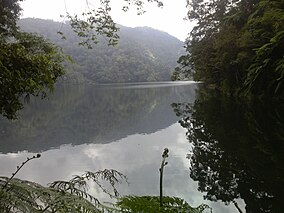Balinsasayao Twin Lakes Natural Park
| Balinsasayao Twin Lakes Natural Park | |
|---|---|
 | |
| Location | Negros Oriental, Philippines |
| Nearest city | Dumaguete |
| Coordinates | 9°21′15″N 123°10′46″E / 9.35417°N 123.17944°E |
| Area | 8,016.05 hectares (19,808.1 acres) |
| Established | November 21, 2000 |
| Governing body | Department of Environment and Natural Resources |
| Balinsasayao Twin Lakes Natural Park | |
Balinsasayao Twin Lakes Natural Park is a
Description
Lakes Balinsasayao and Danao are two small crater lakes separated by a narrow mountain ridge in a hallow surrounded by Mount Guintabon to the west, Mount Balinsasayao to the east, Mount Kalbasaan to the north, and Mount Mahungot to the south.[3] They are located on the eastern slope of the Talinis mountain range which are volcanic in origin. Lake Balinsasayao has a surface area of 76 hectares (190 acres) and maximum depth of around 90 metres (300 ft). The smaller Lake Danao, on the other hand, has a surface area of 30 hectares (74 acres) and maximum depth of around 58 metres (190 ft).[4]
The twin lakes and their surrounding primary and secondary
The park also contains a portion of the 133,000-hectare (330,000-acre) Negros Geothermal Reservation of the Philippine National Oil Company (now Energy Development Corporation) which supplies the energy needs for Dumaguete and southern Negros.[3]
Flora and fauna


The Balinsasayao natural park is an
At least 27 mammalian species have also been documented in the area such as the endangered and endemic
References
- ^ "Proclamation No. 414, s. 2000". Official Gazette of the Republic of the Philippines. Retrieved October 28, 2015.
- ^ "Balinsasayao Watershed Hydrology" (PDF). Silliman Journal. Retrieved October 28, 2015.
- ^ Birdlife International. Retrieved October 28, 2015.
- ^ a b c d "Physical Geography". Official Website of Balinsasayao Twin Lakes Natural Park. Archived from the original on March 4, 2016. Retrieved October 28, 2015.

